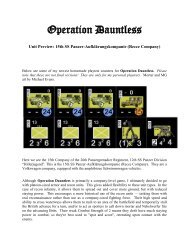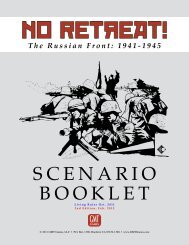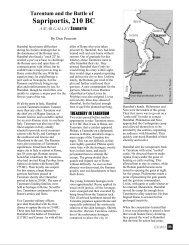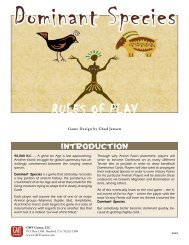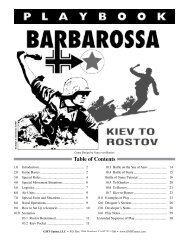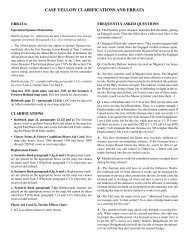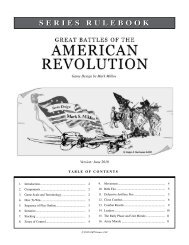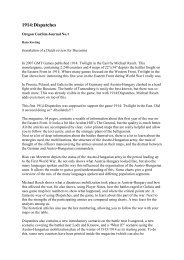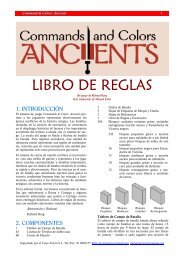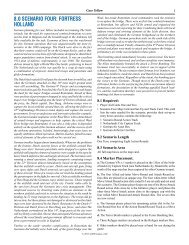You also want an ePaper? Increase the reach of your titles
YUMPU automatically turns print PDFs into web optimized ePapers that Google loves.
12<br />
Newtown <strong>Exclusive</strong> <strong>Rules</strong><br />
Gen. John Sullivan<br />
Cornplanter<br />
HISTORICAL SUMMARY<br />
The Battle of Newtown<br />
By Mark S. Miklos<br />
“The Indian Country is not to be merely overrun, but<br />
destroyed.”<br />
~ General George Washington<br />
I<br />
The Battle of Newtown was the decisive opening<br />
salvo in what has come to be known as the Sullivan-<br />
Clinton Campaign of 1779. This campaign, undertaken<br />
to vanquish the Iroquois, was in response to frontier<br />
conditions in New York and Pennsylvania which had<br />
grown more and more acute during 1778. Britain’s Indian<br />
allies, principally the Seneca, Cayuga, Onondaga<br />
and Mohawk, terrorized the frontier settlements. Some<br />
of their incursions that year still echo through history<br />
with names like the Wyoming and Cherry Valley massacres.<br />
Although the Sullivan-Clinton Expedition is rightly<br />
regarded as a punitive movement it was much more than<br />
that. Its immediate purpose was indeed to give protection<br />
to the frontier settlements by destroying Indian<br />
villages and sources of supply. A second objective was<br />
to interdict British supplies out of Iroquoia, known as<br />
the granary of Niagara. A third objective was to threaten<br />
the forts at Oswego and Niagara, which were bases of<br />
operation for the British in the region. But the Expedition’s<br />
arguably most important strategic objective has<br />
faded in the collective memory.<br />
By 1779 the war was deadlocked. Burgoyne had surrendered<br />
an army at Saratoga, France was an active ally<br />
and other European nations were friendly. Peace was<br />
openly discussed in the British parliament. Washington<br />
and other American leaders saw that independence<br />
with a mere fringe of land along the seacoast would<br />
scarcely be worth the cost of the struggle if the rest<br />
of the continent to the west and north remained in the<br />
hands of the British Empire and its allies. Washington<br />
knew from actual experience the potential wealth of the<br />
fertile regions of the interior. He realized that when the<br />
time came to discuss terms of peace, those rich areas<br />
could only be secured for the young nation if they were<br />
actually possessed by them. Hence, the Sullivan-Clinton<br />
Expedition was at its very core a gamble for an inland<br />
empire.<br />
II<br />
After the Cherry Valley massacre on November 11th<br />
General Washington recognized the necessity of a<br />
decisive response to crush the power of the Indian nations.<br />
His plan for the Indian Expedition was authorized<br />
by Congress on February 25th, 1779 and leadership of<br />
the campaign was first offered to General Gates because<br />
of his seniority. He curtly refused and so, in his stead,<br />
Major General John Sullivan of New Hampshire was<br />
appointed. Brigadier General James Clinton of New<br />
York was made second in command and given direct<br />
charge of the forces being raised in the Mohawk Valley.<br />
He was to march south and join with Sullivan’s forces<br />
at Tioga in northern Pennsylvania.<br />
Clinton was also directed to preempt the Onondagas.<br />
Their ancestral homelands in eastern Iroquoia threatened<br />
the right flank of the proposed line of march of the<br />
combined expedition as it travelled north from Tioga<br />
© 2013 <strong>GMT</strong> <strong>Games</strong>, LLC




